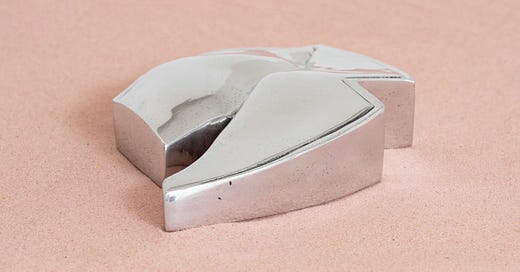Tucked away, on a quiet street in Fitzrovia, the relics are still dancing, I think to myself, as I ponder over the show I saw a few days ago. At first look, Jala Wahid’s Pretend History is certainly no sordid affair. Bright plinths featuring painted checkers and fluffy pillows display friendly figures, and the room packs a playful punch. But the jovial surface appearance of the sculptures on these plinths is not reflected in the true context of the exhibition, and each piece brightly revels in its secrecy.
Pretend History juxtaposes the inherently violent narrative associated between items stored, displacement and displayed, and the tie between archeology and colonialism, through Wahid’s own Kurdish background and the British Empire. During the course of the exhibition, Wahid urges us to question origins and explanations around items, layering multiple narratives into the works while oscillating between objective colonialist brutality and the defiant gaiety of her pieces.
The exhibition itself benefits from Niru Ratnam’s white-cube gallery setting, that neatly mimics the contrast between a sober, museum-like display, and the artist’s personal flair. Wahid took inspiration from many relics she researched at the British museum. These items were often taken from ancient Mesopotamia, present home to many Kurdish communities. Only vague explanation behind their “collection” was employed, yet it is understood that museums such as these benefit greatly from their colonial patrons, and in return reflect their views as history. Each ‘relic’ in the exhibition is a replica, employed by the artist, to ask: what if?
I couldn’t help notice the clever duplicity continually woven in and out of these pieces, using phrases and actions. Many of the sculptures, such as Misery Rattle, 2024 were based off of a matching item from the museum (in this case, a clay baby rattle with a little less flair than this bubblegum pink Jesmonite one) and also featured subtle word play on the rim of its checkered plinth. Misery Rattle’s plinth declares: mine. mine. mine. mine. It is unsure whether this is a sign of ownership, or maybe a sign we should start digging.
Jala Wahid, Misery Rattle. 2024. (Wood, Jesmonite). Niru Ratnam.
The gallery is partially divided by a wall that obstructs the viewer from I Love Ancient Baby (2023), making it visible only after first impressions of the dazzling recast museum relics. These counterparts fill the front room sporting jazzy hues and patterns, obfuscated only by the steady bass music playing one room ahead. My impression was that "I love Ancient Baby" clearly defined the tone and context of the show, and I wonder if this segmented approach was an intentional choice, to allow the viewer a moment's respite with the sculptures' aspirational narrative, soaking in their glow before fully taking in the complete setting.
This video piece is split into two parts and shot and framed as a challenge of sorts, with all the energy and gusto of the short parable you might find on a video screen before playing a slot game in an arcade. Where the first one focuses heavily on energetic dance music and cards shown to soldiers during the invasion of Iraq, outlining monuments they should aim to avoid destroying, the second part delves deeper into the artist’s personal past, narrative and aspirations, featuring her own playing cards. Once more, Wahid reaffirms the two balanced stories of brutality and culture she is spinning.
Jala Wahid, I love Ancient Baby. 2023. (Single Channel Video.) Niru Ratnam.
Pretend History validates existing within this state of violence while also ridiculing it. Juxtaposing what is falsely posed by colonialist structures with what could have been in a state of Kurdish independence, Jala Wahid creates a space for her own personal narrative and descent while taking a satirical view to the information posed by colonialist institutions.
* Pictures courtesy of Niru Ratnam






